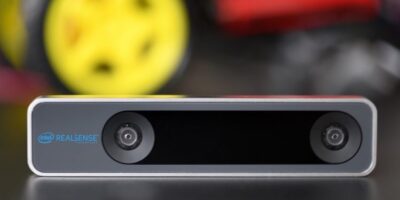Tracking camera uses inside-out tracking, for computing at the edge
Guidance and navigation can be provided for autonomous vehicles using the Intel RealSense Tracking Camera T265. The standlone inside-out tracking device uses proprietary visual inertial odometry simultaneous localisation and mapping (V-SLAM) technology with computing at the edge, making it particularly suitable for applications that require a highly accurate and low-latency tracking solution, for example, robotics, drones, augmented reality (AR) and virtual reality (VR).
The RealSense Tracking Camera T265 was designed to complement Intel’s existing RealSense Depth Cameras and provide a quick path to product development with its next-generation integrated V-SLAM technology.
The camera is powered by the Intel Movidius Myriad 2 vision processing unit (VPU), which directly handles all the data processing necessary for tracking on the machine, providing a small footprint and low-power consumption camera that can be implemented into existing designs or for building IP that requires rich visual intelligence.
Potential applications are where tracking the location of a device is important, especially in locations without GPS service, such as warehouses or remote outdoor areas. In these cases, the camera uses a combination of known and unknown data to navigate to its destination. For example, integrating the T265 into a robot designed for agriculture allows the device to navigate fields in a precise pattern and intelligently adapt to avoid obstacles in its environment, including structures or people. Another example is bringing medical supplies to remote, off-the-grid areas or to a lab inside a hospital ward. Here, the T265 can be used in drone or robotic deliveries due to its wider field of view and optimisation for tracking use cases.
The T265 uses inside-out tracking which means the device does not rely on any external sensors to understand the environment. Intel adds that unlike other inside-out tracking solutions, the T265 delivers six-degrees-of-freedom (6DoF) inside-out tracking by gathering inputs from two onboard fish-eye cameras, each with an approximate 170 degree range of view. The V-SLAM systems construct and continually update maps of unknown environments and the location of a device within that environment. Since all position calculations are performed directly on the device, tracking with the T265 is platform independent and allows the T265 to run on very low-compute devices.
The only hardware requirements are sufficient non-volatile memory to boot the device and a USB 2.0 or 3.0 connection that provides 1.5W of power.




